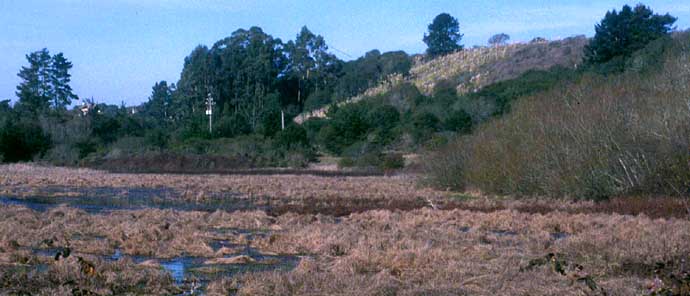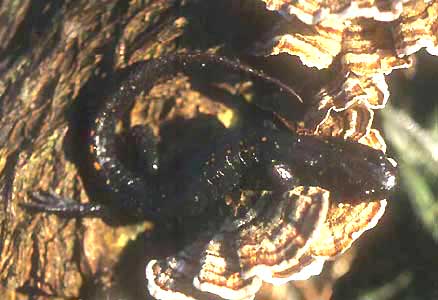


SANTA CRUZ LONG-TOED SALAMANDER
Ambystoma macrodactylum croceum
I first learned about this endangered California salamander from my first field guide (Stebbins 1966). It said this subspecies was "known from only two localities: Valencia Lagoon near Aptos and 1/2 mi. northwest of Ellicott Railroad Station, Santa Cruz Co., California." I learned more details of these sites from a privately circulated paper (Bury 1971) I acquired when I was often visiting the Museum of Vertebrate Zoology, U.C. Berkeley, in the mid 1970s. And then I found out just how close this wonderful salamander may have come to extinction. Valencia Lagoon is right next to Hwy 1 in Aptos. The salamander was discovered to science there on December 2, 1954, when R. W. Russell and James D. Anderson, a grad student of Dr. Robert Stebbins at U.C. Berkeley, discovered it while visiting a friend who lived on Bonita Drive [talk about serendipity... see Russell & Anderson (1956)]. Anderson did a detailed life history of the salamander for his dissertation, comparing this relict coastal population with the more widespread montane populations of Long-toed Salamanders in the Pacific Northwest (Anderson 1960, 1967). At the time, Valencia Lagoon was then a nice temporary pond (i.e., dried up during the summer) with cattails and was 160 yards long and 30 yards wide. When CalTrans widened the two-lane Highway 1 in 1968, they buried half the pond and drained the rest! They basically wiped out the breeding site; mitigation efforts since have been stopgap at best (these and many more details in Ruth 1988). [Calif. Fish & Game has since purchased the remainder of Valencia Lagoon and fenced it, but it sure doesn't look like much. Another mitigation pond was built along Bonita Rd. in the same drainage but it also is not much of breeding site.]
Fortunately, another breeding pond had been discovered in 1956: Ellicott Pond (photo below). Santa Cruz Long-toed Salamanders need ponds that dry up during the summer because their young cannot survive in any permanent pond that has predators like Bullfrogs or fish. Ellicott Pond is another large vernal pond (150 yards by 50 yards in size in a year with normal rainfall) with cattails and other vegetation on which eggs are laid underwater. The adjacent land had been grazed in the 1960s and raspberries grown on the dry pond bed in summer, but in the late 1960s the land was sold for development. The developer planned to drain the entire pond for a huge mobil home park by 19761, wiping out the only other major site for this salamander. Fortunately, there was a groundswell of supportive public opinion to save the habitat and, following a study of the breeding population in winter 1971-72 by students working for Dr. Stebbins, the Santa Cruz board of supervisors turned down the developer's request for rezoning. The pond was purchased as an ecological reserve by Calif. Fish & Game, with license plate funds, in 1973. It is now a national wildlife refuge.

This near disaster stimulated additional research by Steve Ruth and Rhonda Reed and others (e.g., Reed 1978, Ruth 1988); they and others found additional breeding sites near Aptos and in northern Monterey County (e.g., Talent & Talent 1980). By the time of Stebbins (1985) the salamander was known from several additional ponds, including a few sites near Elkhorn Slough. Still, the population is tenuous at best with continued development within its habitat.
The Santa Cruz Long-toed Salamander is one of "mole" salamanders in the family Ambystomatidae. It spends much of its life underground in small mammal burrows. This is among the smallest members of that family. Despite this underground life, their bodies are nicely adapted for swimming -- especially the tail fin (see top photo). With the first big rain of the late autumn, males begin the long trek to the breeding ponds. They can travel distances of more than mile -- quite an accomplishment for an animal only 2.5 inches long! The males arrive first about mid-winter, soon joined by migrating females full of eggs. Courtship and mating takes place in the pond (an elaborate ritual in which males deposit packets of sperm that a willing female picks up and inserts to fertilize her eggs). The entire migration is at night when it is raining, and the outbound migration is the same. Females do not tend the eggs; they leave (weighing a quarter less than when they arrived) on the next rainy winter night. Adult males linger for up to a month and may fertilize additional mates if courting is successful. The larvae hatch a couple months later and eat everything they find in the pond until metamorphosis is triggered by a drying pond. Outbound migration of juveniles is also on rainy nights, and the youngsters do not return until they reach sexual maturity after three years. Away from the pond, they use upland habitat with forests of live oak and much leaf litter. Their primary food is copepods (sow bugs) [this short life history summarized from Ruth 1988, Petranka 1998].
I've looked for these salamanders by standing outside the refuge fence
with binoculars to try to see adults swimming in the pond during the height
of breeding season in mid-winter. But this didn't work. I only managed
to take the photos here when I volunteered to help a permit-holding researcher
take data during an active study. These salamanders are quite variable
in the size and amount of the spots or bars on their upper surface, as
you can see by this comparison of two different adults at the same location.
The patterns are simply individual variation and do not indicate anything
about sex or age:


The Santa Cruz Long-toed Salamander is an ice-age relict now long separated from the remaining populations of Long-toed Salamander in the Pacific Northwest (Washington & Idaho south to northeastern California). They were isolated here on the central coast by the last Pleistocene ice age some 10,000 to 12,000 years ago. Whether this has been enough time to evolve into a separate species is uncertain. Certainly the long-toed salamander group has not been treated to the intense biochemical and molecular analysis as have been the slender salamanders in the genus Batrachoseps. I wonder whether similar studies might show the Santa Cruz Long-toed Salamander to be a species on its own evolutionary orbit...
Whatever that determination, the Santa Cruz Long-toed Salamander is one cool salamander. Considering the cold-blooded nature of amphibians in general, I was surprised that so many were leaving the breeding site on such a cold rainy night that frost formed on the ground. Note the frost particles on the grass in this shot taken first thing in the morning:

Of course, these salamanders are never actually seen out in the open like this photo. They move only on wet nights and hide under logs or in burrows during the day. But they are remarkably programmed to keep moving when conditions are right and to complete their impressive treks to and from the breeding ponds. Just a fabulous, top-notch animal....
On-line resources
A Santa Cruz County website has detailed
life history information summarized from the U.S. Fish & Wildlife
Service's draft recovery plan (1999). A popularized and somewhat anthropomorphic
1997 news story considers the "love
life of the Long-toed Salamander" but still makes nice points. There
are also some more general and very useful web sites on salamanders. My
favorites are:
Anderson, J. D. 1960. A comparative study of coastal and montane populations of Ambystoma macrodactylum. Unpubl. Ph.D. dessert., Univ. Calif. Berkeley.PHOTOS: All photos were taken winter 2002 in Santa Cruz Co., California. All photos © 2002 Don Roberson, all rights reserved.Anderson, J. D. 1967. A comparison of the life histories of coastal and montane populations of Ambystoma macrodactylum in California. Amer. Midl. Natur. 77: 323-355.
Bury, R. B. 1971. Endangered and rare reptiles and amphibians of California. Unpublished project, Mus. Vert. Zool., U.C. Berkeley.
Petranka, J. W. 1998. Salamanders of the United States and Canada. Smithsonian Instit. Press, Washington, D.C.
Reed, R. J. 1978. Population study of the Santa Cruz long-toed salamander (Ambystoma macrodactylum croceum) at Valencia Lagoon 1977-1978, with notes on habitat and occurrence in Santa Cruz and Monterey counties. Calif. Dept. Fish & Game, contract S-1180.
Russell, R. W., and J. D. Anderson. 1956. A disjunct population of the long-nosed [sic] salamander from the coast of California. Herpetologica 12: 137-140.
Ruth, S. B. 1988. The life history and current status of the Santa Cruz Long-toed Salamander. Proceed. Conference on Calif. Herpetology (H. F. De Lisle, P. R. Brown, B. Kaufman, and B. M. McGurty, eds.), Southwestern Herpetologists Society.
Stebbins, R. C. 1966. A Field Guide to Western Reptiles and Amphibians. Houghton Mifflin, Boston.
Stebbins, R. C. 1985. A Field Guide to Western Reptiles and Amphibians. 2d ed. Houghton Mifflin, Boston.
Talent, L. G., and C. L. Talent. 1980. A population of the endangered Santa Cruz long-toed salamander (Ambystoma macrodactylum croceum) from Monterey County, California. Calif. Fish & Game 66: 184-186.